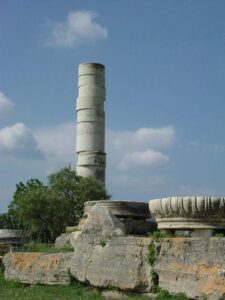Geographical & Historical Outline of Samos
Samos is a verdant island full of olives, pine trees and vines that produces the excellent Samian wine.
It lies in the east part of the Aegean, very close to the Turkish coast with an area of 476 square kilometers and 159 kilometers of coastline.
The straits of Samos separating the island from the mainland are a mere 18 nautical miles across.
Its fertile terrain is dominated by the Mount Kerki, the highest mountain on the Aegean islands, with a height of 1440 meters, and other lower peaks.
The morphology of the island exhibits great variety with small plains alternating with semi-mountainous regions.
Geographical & Historical Outline of Samos
The island was first inhabited by Karians and its ancient name was Parthenia.
It enjoyed great power and prosperity under the tyrant Polykrates (54o BC).
During the Persian Wars it was conquered by the Persians, and later became a member of the First Athenian Confederacy, from which it seceded in 440 BC. Pericles sent a strong force and captured the island after a long siege.
In 129 BC, it became part of the Roman province and during Byzantine times it was part of the province of the Cyclades.
It was captured by the Franks (1204) and, after the Fall of Constantinople to the Turks (1453), it was abandoned, its Greek inhabitants seeking refuge in nearby Chios.
The islanders of Samos took an active part in the Greek War of Independence of 1821.
The island was united with free Greece on 11 November 1912.


